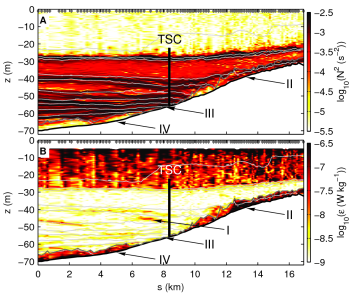
Internal-Wave Mixing

Internal waves are ubiquitous features in the ocean. They play an important role in the energy budget of the ocean due to their ability to distribute energy over large distances, both vertically and horizontally, and among a large range of scales by non-linear interactions and their ability to generate small-scale turbulence by breaking. The latter is believed to be an important energy source for diapycnal mixing of heat, salt, and dissolved substances.
In our group, we use the Baltic Sea as a natural laboratory to study these processes with focus on wind-generated near-inertial waves. These waves with a period of approximately 14 h often form the strongest signal in measured and modeled currents. We showed that the vertical shear associated with the near-inertial waves triggers shear instabilities, and thus mixing, in the strongly stratified interior region of the deep basins of the Baltic Sea (van der Lee and Umlauf, 2011). More recently, measurements near one of the slopes of the Bornholm Basin (see figure to the right) showed that near-inertial waves are also one of the most important energy sources for boundary mixing (Lappe and Umlauf, 2016). This is in line with results from the Baltic Sea Tracer Releaser Experiment (Holtermann et al., 2012; Holtermann and Umlauf, 2012; Holtermann et al., 2014), suggesting that boundary mixing processes dominate net vertical mixing in the deep layers of the Baltic Sea.